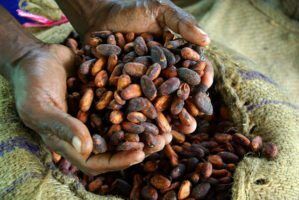

Energy
Climate Smart Chocolate
With Valentine’s Day just round the corner, chocolate is one of the top three symbols of the most romantic day of the year. But, does that chocolate come at a price to cocoa growers and the environment? The world’s chocolate and cocoa supply originates from roughly three million cocoa farms, the vast majority of them operated by smallholders (family farmers cultivating no more than a few hectares of land). Currently, almost three-quarters of all cocoa produced in West and Central Africa, with the remainder coming from Asia (about 10 percent) and Latin America (about 17 percent)
These small-scale cocoa farmers— many of whom are already struggling to earn a decent living—are also contending with the effects of climate change, including warmer temperatures, less predictable rainfall patterns and diseases that infest the cocoa pod. Cocoa farming can also be a driver of deforestation when farmers seek to expand into tropical forest areas. Also,child labor has historically been widespread in the cocoa industry in West Africa. While the industry has taken steps to reduce the worst forms of child labor in the past decade, child labor remains a significant concern.
However, this is where certification labels – such as the little green frog seal that represents the Rainforest Alliance – can make a drastic difference
The Rainforest Alliance seeks to address challenges faced by cocoa farmers through the Sustainable Agriculture Network (SAN)/Rainforest Alliance certification system,which is made up of strictsocial, environmental and agronomic criteria. The SAN standards cover ecosystem conservation, worker rights and safety, wildlife protection, water and soil conservation, agrochemical reduction, decent housing, and legal wages and contracts for workers. As of December 2014, there were over 280,000 Rainforest Alliance Certified cocoa farms in 17 countries.
Independent studies have shown the benefits of certification to farmers and the environment, and found greater adoption of key social, environmental and agronomic sustainability practices on Rainforest Alliance Certified cocoa farms than on nearby non-certified farms.
These practices included:
– Using personal protective equipment for agrochemical applications
– Using safe agrochemical storage practices
– Maintaining protective buffers around water bodies
– Retaining or planting shade trees
– Adoption of more practices to improve cocoa quality, such as pod breaking and fermentation
– Replanting or rejuvenating old cocoa trees
The impacts to the farmer and their families speak for themselves, with one study in Ghana finding that cocoa yields were significantly higher on Rainforest Alliance Certified farms (averaging 394 kg/hectare) than on uncertified farms (averaging 251 kg/hectare).
Of these certified farms, 67 percent of the farmers said that the returns from certification were “much more” than what they invested in the process.
Independent audit results also show that certification helps confront the challenges faced by cocoa farmers, such as effectively curtailing the employment of minors on cocoa farms, including limiting work to tasks that are not hazardous and limiting work hours to levels that do not interfere with schooling. Additionally, audit results indicate that school-aged children of farmers in certified groups have access to education.
Rainforest Alliance certification shows that by adopting environmentally and socially sustainable farming practices that help local ecosystems and communities thrive, together we can create a sustainable future.


 Environment10 months ago
Environment10 months agoAre Polymer Banknotes: an Eco-Friendly Trend or a Groundswell?

 Environment12 months ago
Environment12 months agoEco-Friendly Home Improvements: Top 7 Upgrades for 2025

 Features9 months ago
Features9 months agoEco-Friendly Cryptocurrencies: Sustainable Investment Choices

 Features10 months ago
Features10 months agoEco-Friendly Crypto Traders Must Find the Right Exchange





























